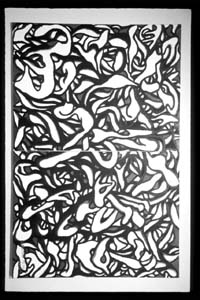![[Metroactive Arts]](/arts/gifs/art468.gif)
![[Metroactive Arts]](/arts/gifs/art468.gif)
[ Arts Index | Metro | Metroactive Central | Archives ]
Cultural Currents in Turmoil
The magnetic, driving power of repressed expression marks the work of four Chinese American artists
By Ann Elliott Sherman
ALTHOUGH THE exhibit Root and Land is subtitled Four Chinese American Artists From the Bay Area, the featured artists didn't study here but in either Taiwan or mainland China. The currents of cultural expectation both groups swim against to define themselves, then, is not that of mainstream America but of their homelands. What seems at first glance to be rather conservative painting is, in fact, for these artists, a radical departure from the stylistic confines of Chinese tradition.
Curator and participant Arthur Mu-sen Kao writes as though it is common knowledge, but the difference between the two groups is striking to a first-time viewer. The work of mainland Chinese artists Changming Meng and Fei Shao clearly owes much to modern European influence, while Taiwanese painters Kao and Chung-ray Fong create contemporary adaptations of the traditional Chinese aesthetic. Apparently, the magnetic power of repressed expression or lost connection drives artistic engines everywhere.
Meng's predominantly black-and-white acrylics, full of curving lines that occasionally take on identifiable shapes, are reminiscent of Jean Dubuffet's automatic drawings of the 1960s, although Meng's energy is considerably more focused and controlled than determinedly irrational. The thick lines wrapped around bulky shapes in pieces like A View of the Morning translate here as a thicket of biomorphic graffiti.
Falling into the dreamlike, folk-tale narratives of Shao's paintings on rice paper is easy, but these colorful illustrations also roil with the dark psychological undercurrents of a good fairy tale.
Though the primary impression of Song of the Homeward is the astounding number of traceable influences--I saw smatterings of Picasso, Chagall and Matisse, to which Kao would add Central Asian wall painting, woodblock prints and Chinese folk art--these are filtered through a reticent sensibility. Viewers must look within the pleasant scene to puzzle out clues to the subtext.
Whether this reticence is by natural inclination or due to the artist's experience of the Cultural Revolution at a tender age, Shao effectively creates a world where things are not always what they first appear. Though she stands deferentially behind the whip-wielding male, the woman in Song clearly sides with the nature he would subjugate, to the point that her own hair is just a longer version of the pistils of the flower she wears.
On one side, her gaze is inward; the other eye plays like the omniscient third eye, centered in her forehead. The seated man, in contrast, presents a masklike visage, with outsized eyes that stare without seeing. Between them, Shao has outlined a small hole. Though still cracking the whip, this patriarchal power is brain dead.
A purer homage to Matisse is Red Blossom With Green Willow, a clothed odalisque before a carved window screen. Shao's Imagine and Soar functions similarly to Klee's Cat and Bird. A face with flowing, unfocused yellow eyes signals that the cherry-eating bird behind it--swimming through the sky with fish, one wing supporting a half-child, half-woman fetus, the other morphing into leaves--is the mind in flight. Rich in both color and symbolic imagery, this painting supplies enough grist for a double major's thesis in art history and psychology.
USING WESTERN techniques like collage and color fields, Fong paints abstracts that nonetheless evoke the feeling, if not the stereotypic look, of traditional Chinese landscape paintings. In Painting 19925, the upper two-thirds of the canvas is translucently collaged with narrow vertical strips of rice papers inscribed with Chinese characters. The wash applied over these characters blurs the ink into black clouds.
Below, an area of overlaid green and blue paint in sponged and dripped textures rises and falls much like a mountain range viewed at a distance. At its base, a ground of blocked green and blue is revealed--abstract geometry suggesting cultivated fields. Tones of steely gray form an angled patchwork swept with a dripping mist of watery white that is vertical in this piece and horizontal in Painting 19917.
Kao was trained as a literati painter to combine calligraphy, poetry and painted imagery, striving to achieve a balance of reason and emotion. This background is most obvious in Joy of Life, in which an angular nude male raptly plays a samisen, flanked on each side by Chinese text.
The beveled body of the long-neck stringed instrument reiterates the body's line; the fingering of the fret is calligraphically rendered in four uneven lines. The passionate side of the visual equation is captured in the blurred, rhythmic motion of his strumming hand, blending his body with his instrument, man and the music as one.
[ Metro | Metroactive Central | Archives ]
This page was designed and created by the Boulevards team.

Biomorphic Graffiti: Changming Meng's "Outside of Window," an acrylic on canvas from 1966.
Root and Land runs through Feb. 21 at the Natalie and James Art Gallery, Art Bldg., San Jose State University. Arthur Kao lectures on contemporary Chinese painting Tuesday (Feb. 4), 56pm, in Rm. 133, Art Bldg., SJSU, followed by an artists' reception at 6pm. (408/924-4328)
From the January 30-February 5, 1997 issue of Metro
Copyright © 1997 Metro Publishing, Inc.